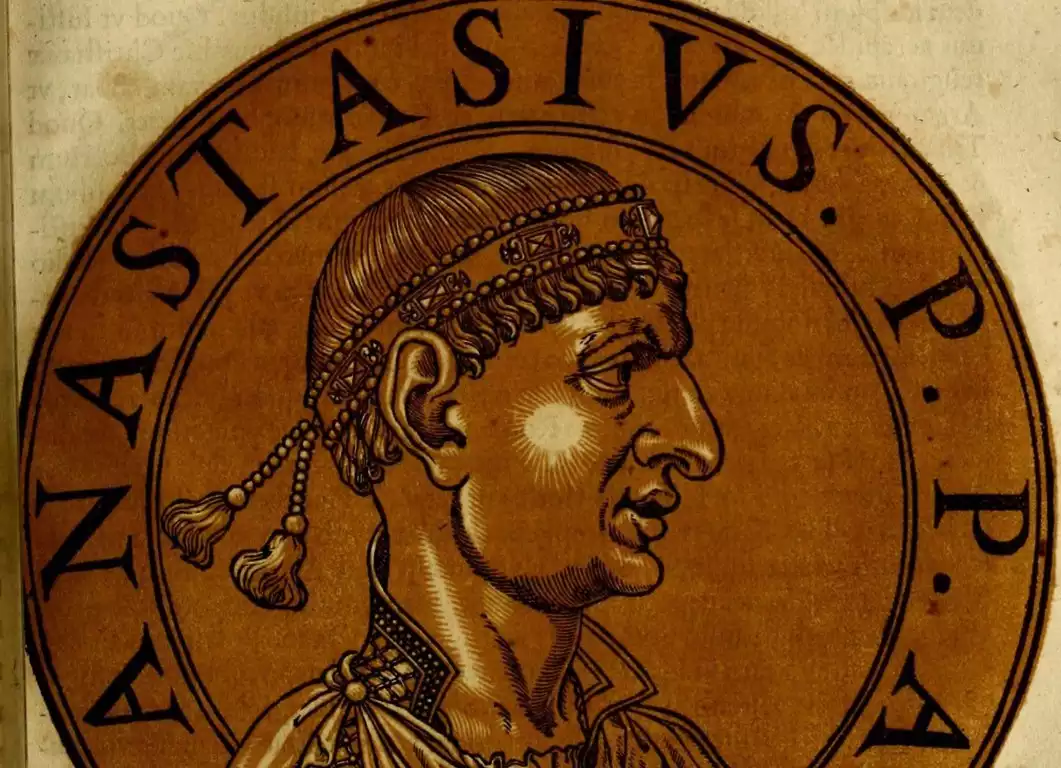
Emperor Anastasius I, born in 430 AD and passing in 518 AD, was a pivotal figure in the history of the Byzantine Empire. Renowned for his significant fiscal and monetary reforms, Anastasius I’s reign marked a substantial economic and administrative transformation. His policies not only stabilized the empire’s finances but also laid the groundwork for future prosperity.
Early Life and Ascension to the Throne
The early life of Emperor Anastasius I was marked by modest beginnings. Born in Dyrrhachium, a city on the Adriatic coast, his rise to power was neither predicted nor straightforward. Before his ascension, Anastasius was known for his administrative skills, serving in various lower-ranking positions within the Byzantine bureaucracy. His appointment as emperor in 491 AD, following the death of Emperor Zeno, was a turning point in Byzantine history. His rise to the throne was characterized by a blend of political acumen and fortunate circumstances, setting the stage for a reign focused on reform and stability.
Anastasius I’s ascension was initially met with mixed reactions. The empire he inherited was riddled with financial difficulties and religious discord. However, his administrative prowess soon became apparent, as he embarked on a journey to revitalize the empire’s economic foundations.
Fiscal and Monetary Reforms
Emperor Anastasius I’s reign was distinguished by a series of bold fiscal and monetary reforms. Understanding the crucial role of a stable economy, he implemented policies that were both innovative and effective. One of his most significant reforms was the introduction of a new copper coin, the follis. This currency reform not only facilitated trade within the empire but also streamlined tax collection, enhancing the state’s revenue.
Moreover, Anastasius I meticulously reorganized the empire’s taxation system. He reduced the burden of indirect taxes, which had been a source of grievance among the populace. His tax reforms aimed at fairness and efficiency, ensuring a more equitable distribution of fiscal responsibilities. These measures not only bolstered the empire’s treasury but also garnered the emperor widespread support among his subjects.
The emperor’s fiscal strategies extended beyond mere taxation reforms. He was keen on reducing unnecessary expenditures, implementing strict budgetary controls, and curbing corruption within the administrative ranks. His efforts in streamlining government spending played a crucial role in stabilizing the Byzantine economy.
Anastasius I’s reign was not without challenges. He faced opposition from those who resisted change, as well as from external threats. Yet, his steadfast commitment to fiscal prudence and administrative efficiency set a precedent for future Byzantine emperors. His reforms not only restored economic stability but also enabled the empire to thrive in the subsequent years.
Religious Policies and Controversies
Emperor Anastasius I’s reign also witnessed significant religious upheaval. A devout follower of the Monophysite doctrine, which emphasized the singular divine nature of Christ, Anastasius found himself at odds with the Chalcedonian creed predominant in the empire. His religious leanings led to tensions with the predominantly Chalcedonian hierarchy, including numerous bishops and the influential patriarch of Constantinople.
Despite these challenges, Anastasius sought a conciliatory approach, promoting religious tolerance within his domain. He resisted imposing his religious views on his subjects, instead advocating for a unified Christian front. This approach, however, was met with limited success, as religious divisions continued to plague the empire, affecting both social harmony and political stability.
Diplomatic Endeavors and Military Campaigns
In the realm of foreign affairs, Emperor Anastasius I demonstrated considerable diplomatic skill. He navigated complex relationships with neighboring powers, including the Sassanid Persians and various barbarian tribes. His reign was characterized by a blend of diplomatic engagements and military actions, aimed at protecting the empire’s borders and maintaining its influence.
Anastasius I’s military campaigns were largely defensive, focusing on fortifying the empire’s frontiers, particularly in the Balkans and the eastern provinces. His fortification efforts, most notably the Anastasian Wall near Constantinople, were crucial in safeguarding the empire from external threats. Additionally, his diplomatic acumen helped in forging temporary peace with the Persians, bringing a brief respite from the long-standing hostilities between the two empires.
Emperor Anastasius I’s legacy is a testament to his profound impact on the Byzantine Empire. His fiscal and monetary reforms revitalized the empire’s economy, laying the foundations for its future prosperity. His approach to religious policy, though controversial, highlighted his commitment to maintaining unity within his diverse empire. In foreign affairs, his diplomatic and military strategies helped in securing the empire’s borders and enhancing its standing among neighboring states.
Anastasius I’s reign marked a period of transition and transformation, setting the stage for the golden age of the Byzantine Empire. His prudent policies and administrative skills left an indelible mark on the empire’s history, making him one of the most significant Byzantine emperors.
References
- Evans, James Allan Stewart. “The Age of Justinian: The Circumstances of Imperial Power.” Routledge, 1996.
- Garland, Lynda. “Byzantine Empresses: Women and Power in Byzantium, AD 527-1204.” Routledge, 1999.
- Greatrex, Geoffrey. “The Roman Eastern Frontier and the Persian Wars.” Routledge, 2002.
- Haldon, John. “Byzantium in the Seventh Century: The Transformation of a Culture.” Cambridge University Press, 1990.
